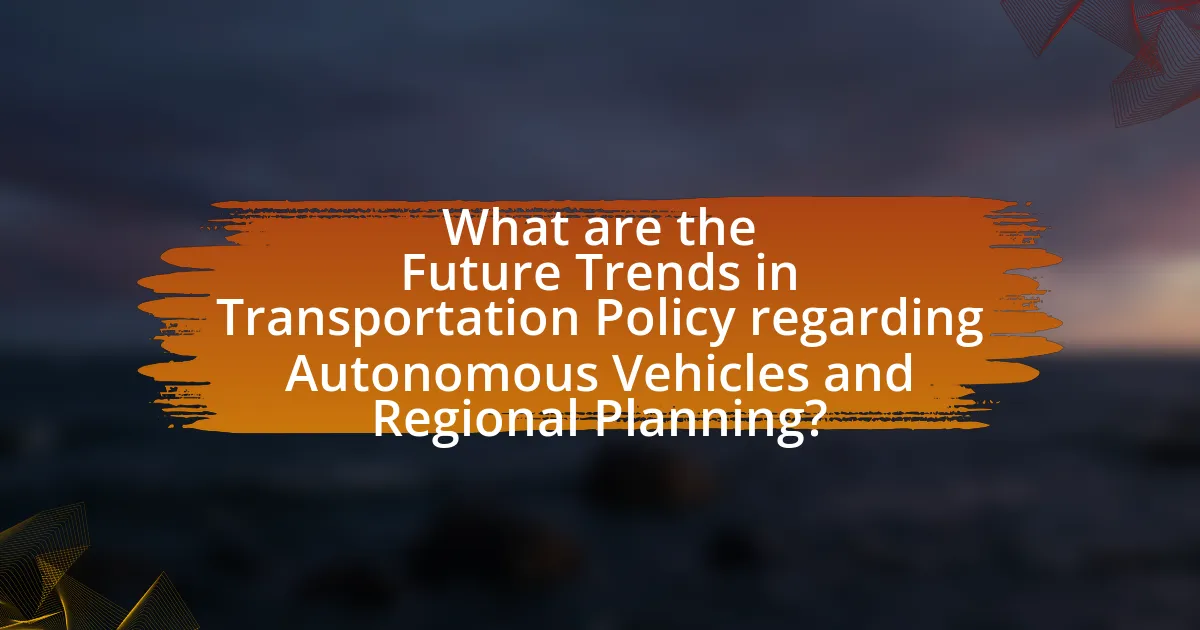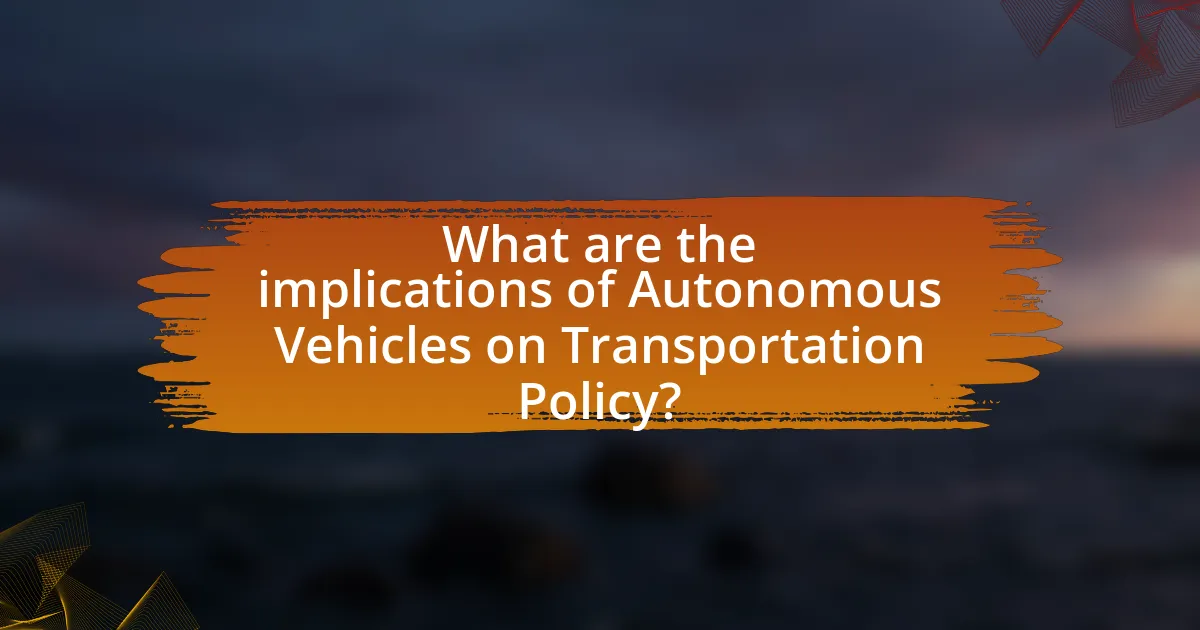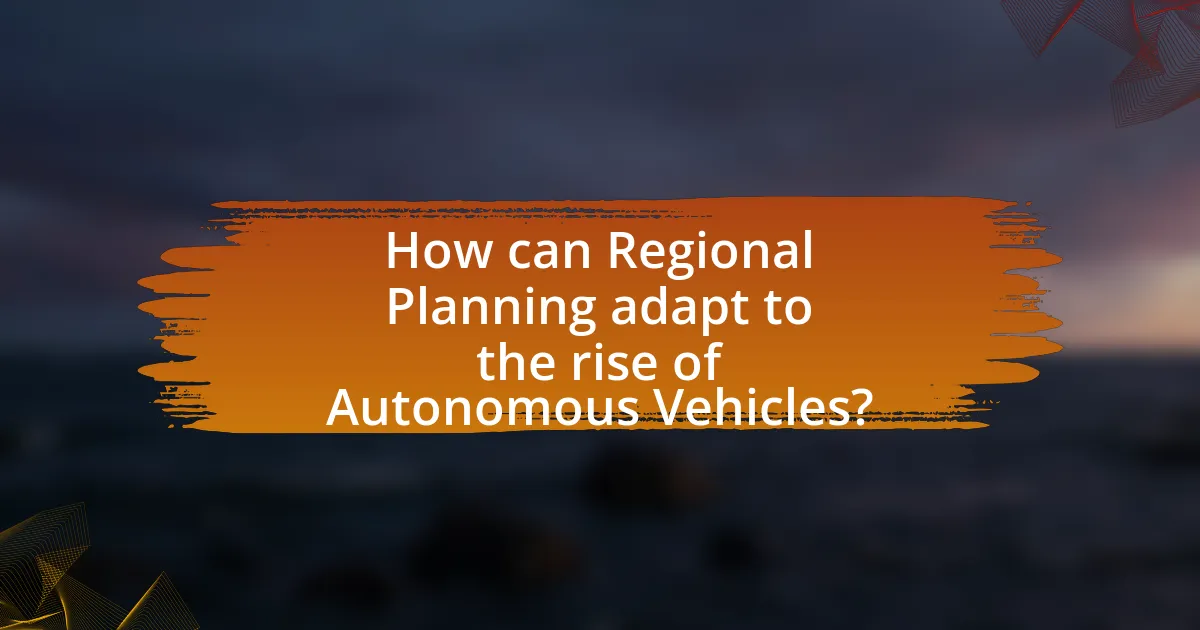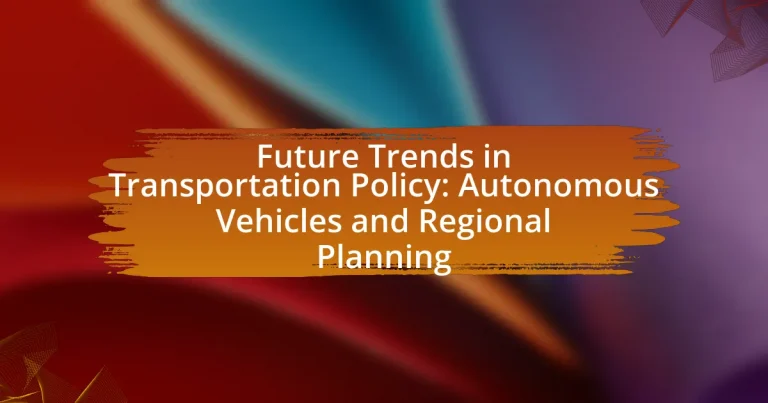The article focuses on the future trends in transportation policy concerning autonomous vehicles and regional planning. It highlights the integration of autonomous systems into urban infrastructure, the development of regulatory frameworks prioritizing safety and efficiency, and the impact of technological advancements such as artificial intelligence and sensor technology. Key discussions include how autonomous vehicles reshape transportation policy, influence safety regulations, and affect urban mobility and infrastructure. Additionally, the article examines the role of regional planning in facilitating the adoption of autonomous vehicles, the challenges planners face, and the economic implications of this transformative technology on job markets and municipal costs.

What are the Future Trends in Transportation Policy regarding Autonomous Vehicles and Regional Planning?
Future trends in transportation policy regarding autonomous vehicles and regional planning include increased integration of autonomous systems into urban infrastructure and the development of regulatory frameworks that prioritize safety and efficiency. Policymakers are focusing on creating smart city initiatives that incorporate autonomous vehicles, which can lead to reduced traffic congestion and improved public transportation options. For instance, cities like San Francisco and Austin are piloting autonomous vehicle programs that align with regional planning efforts to enhance mobility and accessibility. Additionally, the adoption of data-driven decision-making in transportation planning is expected to facilitate better coordination between autonomous vehicle deployment and land use policies, ultimately promoting sustainable urban development.
How are Autonomous Vehicles reshaping Transportation Policy?
Autonomous vehicles are reshaping transportation policy by necessitating new regulations and frameworks that address safety, liability, and infrastructure. As these vehicles become more prevalent, policymakers are compelled to create guidelines that ensure public safety while fostering innovation. For instance, the National Highway Traffic Safety Administration (NHTSA) has issued guidelines for the testing and deployment of autonomous vehicles, emphasizing the need for a regulatory environment that adapts to technological advancements. Additionally, cities are re-evaluating zoning laws and infrastructure investments to accommodate the unique requirements of autonomous vehicles, such as dedicated lanes and smart traffic management systems. This shift in policy is evident in various pilot programs and legislative initiatives across states, reflecting a proactive approach to integrating autonomous technology into existing transportation frameworks.
What technological advancements are driving Autonomous Vehicle development?
Technological advancements driving Autonomous Vehicle development include artificial intelligence, sensor technology, and connectivity. Artificial intelligence enables vehicles to process vast amounts of data from their surroundings, facilitating real-time decision-making. Sensor technology, such as LIDAR and cameras, provides detailed environmental mapping, essential for navigation and obstacle detection. Connectivity through vehicle-to-everything (V2X) communication enhances safety and efficiency by allowing vehicles to interact with each other and infrastructure. These advancements are supported by significant investments in research and development, with the autonomous vehicle market projected to reach $557 billion by 2026, according to a report by Allied Market Research.
How do Autonomous Vehicles impact urban mobility and infrastructure?
Autonomous vehicles significantly enhance urban mobility and reshape infrastructure by improving traffic flow, reducing congestion, and enabling more efficient land use. Studies indicate that the integration of autonomous vehicles can lead to a 20-30% reduction in traffic congestion due to optimized routing and reduced human error. Furthermore, these vehicles can facilitate the development of smart infrastructure, such as adaptive traffic signals and dedicated lanes, which can accommodate increased vehicle efficiency. The potential for reduced parking demand, as autonomous vehicles can drop passengers off and park themselves, allows cities to repurpose parking spaces for green areas or housing, thus transforming urban landscapes.
What role does Regional Planning play in the adoption of Autonomous Vehicles?
Regional planning plays a crucial role in the adoption of autonomous vehicles by establishing the infrastructure and regulatory frameworks necessary for their integration into urban environments. Effective regional planning ensures that road networks, public transportation systems, and land use policies are designed to accommodate autonomous vehicles, enhancing safety and efficiency. For instance, cities that prioritize smart infrastructure, such as dedicated lanes for autonomous vehicles and advanced traffic management systems, can facilitate smoother operations and reduce congestion. Additionally, regional planning can address zoning laws and public transit integration, which are essential for maximizing the benefits of autonomous vehicles, as evidenced by studies showing that well-planned urban areas can significantly improve mobility and reduce emissions.
How can Regional Planning facilitate the integration of Autonomous Vehicles?
Regional planning can facilitate the integration of autonomous vehicles by establishing infrastructure that supports their operation, such as dedicated lanes and smart traffic management systems. This approach ensures that the necessary technological and physical frameworks are in place to accommodate autonomous vehicles, enhancing safety and efficiency. For instance, cities like San Francisco have implemented pilot programs that integrate autonomous vehicle testing with existing public transportation systems, demonstrating the effectiveness of coordinated planning efforts. Additionally, regional planning can promote policies that encourage collaboration between government agencies and private companies, fostering innovation and investment in autonomous vehicle technology.
What challenges do planners face in accommodating Autonomous Vehicles?
Planners face significant challenges in accommodating Autonomous Vehicles (AVs), primarily related to infrastructure adaptation, regulatory frameworks, and public acceptance. Infrastructure must be updated to support AV technology, including the installation of sensors and communication systems that enable vehicle-to-infrastructure interactions. Regulatory frameworks need to evolve to address liability, insurance, and safety standards specific to AVs, as current laws may not adequately cover these new technologies. Additionally, public acceptance is crucial; planners must engage communities to address concerns about safety, privacy, and the potential impact on employment in driving-related sectors. These challenges are underscored by studies indicating that successful integration of AVs requires comprehensive planning and collaboration among various stakeholders, including government agencies, private companies, and the public.

What are the implications of Autonomous Vehicles on Transportation Policy?
Autonomous vehicles significantly impact transportation policy by necessitating updates to regulations, infrastructure, and safety standards. As these vehicles become more prevalent, policymakers must address issues such as liability in accidents, data privacy, and cybersecurity, which differ from traditional vehicle regulations. For instance, the National Highway Traffic Safety Administration (NHTSA) has issued guidelines for the testing and deployment of autonomous vehicles, emphasizing the need for a regulatory framework that ensures public safety while fostering innovation. Additionally, the integration of autonomous vehicles into existing transportation systems may require investments in smart infrastructure, such as connected traffic signals and dedicated lanes, to optimize traffic flow and enhance safety. These changes reflect a shift in transportation policy towards accommodating new technologies while ensuring equitable access and environmental sustainability.
How do Autonomous Vehicles influence safety regulations in Transportation Policy?
Autonomous vehicles significantly influence safety regulations in transportation policy by necessitating the development of new frameworks that address their unique operational characteristics. As these vehicles operate with advanced technologies such as artificial intelligence and machine learning, traditional safety regulations, which often focus on human drivers, become inadequate. For instance, the National Highway Traffic Safety Administration (NHTSA) has issued guidelines that encourage states to create regulations that specifically account for the testing and deployment of autonomous vehicles, emphasizing the need for safety standards that reflect their capabilities and limitations. This shift in regulatory focus aims to ensure that autonomous vehicles can be safely integrated into existing traffic systems, thereby enhancing overall road safety.
What are the potential safety benefits of Autonomous Vehicles?
Autonomous vehicles (AVs) have the potential to significantly enhance road safety by reducing human error, which is responsible for approximately 94% of traffic accidents according to the National Highway Traffic Safety Administration. AVs utilize advanced sensors and algorithms to detect and respond to their environment more quickly and accurately than human drivers, thereby minimizing the likelihood of collisions. Furthermore, studies indicate that the widespread adoption of AV technology could lead to a reduction in traffic fatalities by up to 90% over time, as these vehicles are designed to follow traffic laws and maintain safe driving practices consistently.
How might liability laws change with the rise of Autonomous Vehicles?
Liability laws are likely to shift from individual drivers to manufacturers and software developers with the rise of Autonomous Vehicles. As these vehicles operate based on complex algorithms and artificial intelligence, determining fault in accidents becomes more challenging, necessitating a legal framework that holds manufacturers accountable for malfunctions or errors in the vehicle’s operation. For instance, the National Highway Traffic Safety Administration (NHTSA) has indicated that as vehicles become more automated, the legal responsibility may transition to the companies that design and produce the technology, rather than the human operator. This change reflects a growing recognition that traditional liability models may not adequately address the unique challenges posed by autonomous driving technology.
What economic impacts do Autonomous Vehicles have on Transportation Policy?
Autonomous vehicles significantly influence transportation policy by altering infrastructure investment, regulatory frameworks, and economic models. The introduction of autonomous vehicles necessitates substantial changes in road infrastructure, including the development of smart roads and enhanced traffic management systems, which can lead to increased public spending and shifts in funding priorities. Additionally, the regulatory landscape must adapt to address liability issues, safety standards, and data privacy concerns associated with autonomous technology. Economic models are also impacted as traditional revenue sources, such as fuel taxes, may decline due to increased vehicle efficiency and the potential for shared mobility services. According to a report by the McKinsey Global Institute, the widespread adoption of autonomous vehicles could generate up to $1.3 trillion in economic value annually by 2030, highlighting the transformative potential of this technology on transportation policy and economic structures.
How can Autonomous Vehicles affect job markets in transportation sectors?
Autonomous vehicles can significantly disrupt job markets in transportation sectors by reducing the demand for traditional driving roles. As these vehicles become more prevalent, jobs such as truck drivers, taxi drivers, and delivery personnel may decline, with estimates suggesting that up to 3.5 million trucking jobs could be at risk in the United States alone due to automation. Conversely, the rise of autonomous vehicles may create new job opportunities in technology development, vehicle maintenance, and regulatory compliance, indicating a shift in the types of skills required in the transportation workforce. This transformation necessitates workforce retraining and adaptation to meet the evolving demands of the industry.
What are the cost implications for municipalities adopting Autonomous Vehicles?
The cost implications for municipalities adopting Autonomous Vehicles (AVs) include significant initial investments in technology, infrastructure upgrades, and ongoing operational expenses. Municipalities must allocate funds for the acquisition of AVs, which can range from hundreds of thousands to millions of dollars depending on the fleet size and vehicle type. Additionally, infrastructure enhancements, such as smart traffic signals and dedicated lanes, are necessary to support AV operations, potentially costing municipalities millions more.
Ongoing costs include maintenance, insurance, and the need for skilled personnel to manage and operate AV systems. A study by the American Public Transportation Association indicates that while AVs can reduce long-term operational costs through efficiency gains, the upfront financial burden can be substantial, with estimates suggesting that municipalities may need to invest between $1 million to $5 million per mile of roadway to fully integrate AV technology.

How can Regional Planning adapt to the rise of Autonomous Vehicles?
Regional planning can adapt to the rise of autonomous vehicles by integrating smart infrastructure, revising zoning laws, and enhancing public transportation systems. Smart infrastructure, such as dedicated lanes and traffic management systems, can facilitate the safe operation of autonomous vehicles, improving traffic flow and reducing congestion. Revising zoning laws to promote mixed-use developments can encourage walkability and reduce reliance on personal vehicles, aligning with the capabilities of autonomous transport. Additionally, enhancing public transportation systems to incorporate autonomous shuttles can provide efficient last-mile connectivity, ensuring that regional transit networks remain robust and accessible. These adaptations are essential as studies indicate that autonomous vehicles could significantly alter travel patterns and urban design, necessitating proactive planning measures.
What strategies can be employed for effective Regional Planning with Autonomous Vehicles?
Effective regional planning with autonomous vehicles can be achieved through integrated transportation systems, land-use planning, and data-driven decision-making. Integrated transportation systems ensure seamless connectivity between autonomous vehicles and existing public transit, enhancing accessibility and reducing congestion. Land-use planning focuses on creating mixed-use developments that encourage walkability and reduce reliance on personal vehicles, thereby optimizing the deployment of autonomous vehicles. Data-driven decision-making utilizes real-time traffic data and predictive analytics to inform infrastructure investments and policy adjustments, ensuring that regional planning adapts to the evolving landscape of autonomous vehicle technology. These strategies are supported by studies indicating that regions implementing such approaches experience improved mobility outcomes and reduced environmental impacts.
How can public transportation systems be integrated with Autonomous Vehicles?
Public transportation systems can be integrated with Autonomous Vehicles (AVs) by creating a multimodal transportation network that allows seamless transitions between traditional public transit and AV services. This integration can be achieved through coordinated scheduling, shared data platforms, and infrastructure that supports both modes of transport. For instance, cities like San Francisco have begun pilot programs where AVs serve as first-mile/last-mile solutions, connecting passengers to bus and train stations, thereby enhancing overall accessibility and efficiency. Additionally, research from the Transportation Research Board indicates that integrating AVs into public transit can reduce congestion and improve service frequency, making public transportation more attractive to users.
What zoning changes are necessary to accommodate Autonomous Vehicles?
Zoning changes necessary to accommodate Autonomous Vehicles (AVs) include the reconfiguration of land use regulations to support dedicated AV lanes, parking structures designed for AVs, and mixed-use developments that integrate transportation hubs. These changes are essential as AVs require specific infrastructure to operate efficiently and safely, such as designated drop-off zones and charging stations. For instance, cities like San Francisco have begun to implement policies that allow for the conversion of underutilized parking spaces into AV-friendly areas, reflecting a shift in urban planning to prioritize AV integration. This adaptation is supported by studies indicating that AVs can reduce the need for extensive parking, thus freeing up land for other uses, which further validates the necessity of these zoning changes.
What best practices should be considered for future Transportation Policy?
Future transportation policy should prioritize integration of autonomous vehicles into existing infrastructure. This integration requires collaboration between government agencies, private sector stakeholders, and communities to ensure safety and efficiency. For instance, the National Highway Traffic Safety Administration (NHTSA) emphasizes the need for regulatory frameworks that adapt to technological advancements while maintaining public safety. Additionally, policies should promote sustainable practices, such as reducing emissions and enhancing public transit options, as highlighted by the Environmental Protection Agency’s (EPA) guidelines on sustainable transportation. Furthermore, data-driven decision-making should guide regional planning efforts, utilizing analytics to optimize traffic flow and resource allocation, as supported by studies from the Transportation Research Board.
How can stakeholder engagement improve Transportation Policy outcomes?
Stakeholder engagement can significantly improve Transportation Policy outcomes by ensuring that diverse perspectives and needs are considered in the decision-making process. Engaging stakeholders, such as community members, transportation agencies, and industry experts, leads to more informed policies that reflect the realities of those affected. For instance, a study by the Transportation Research Board found that inclusive stakeholder processes resulted in policies that better addressed local transportation challenges and increased public support for initiatives. This collaborative approach not only enhances the relevance of transportation policies but also fosters trust and accountability among stakeholders, ultimately leading to more effective implementation and sustainability of transportation initiatives.
What lessons can be learned from early adopters of Autonomous Vehicle technology?
Early adopters of Autonomous Vehicle technology demonstrate the importance of regulatory frameworks and public acceptance in successful implementation. For instance, cities like San Francisco and Phoenix have established guidelines that facilitate testing while ensuring safety, which has led to increased public trust and participation in autonomous vehicle programs. Additionally, data from these early adopters indicate that collaboration between technology companies and local governments is crucial for addressing infrastructure needs and integrating autonomous vehicles into existing transportation systems. This collaboration has resulted in improved traffic management and reduced congestion, as evidenced by studies showing a 20% decrease in traffic delays in areas with active autonomous vehicle trials.


